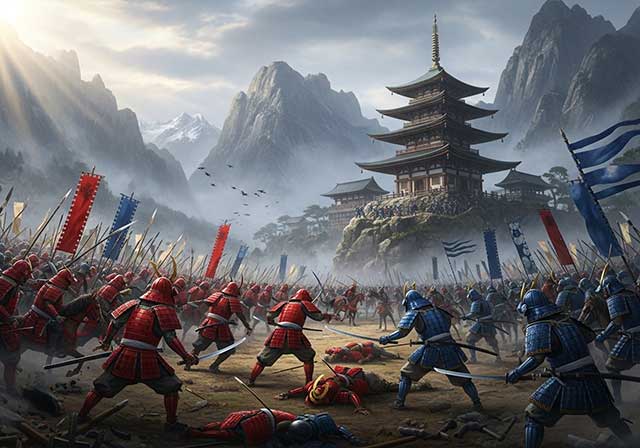
The conflict between the Soga and Mononobe clans, who were related to the imperial dynasty, arose on religious grounds. The Soga supported Buddhism, which had come from Korea, while the Mononobe remained faithful to Shintoism and fiercely opposed the spread of “foreign teachings.” Tensions reached a peak after the death of Emperor Yomei in 587.
The struggle for the throne
At that time, the clans were led by Soga no Umako and Mononobe no Moria, both of whom held ministerial posts at the emperor's court. Moria was dissatisfied with Yomei's patronage of Buddhism and supported Prince Anahobe in his claim to the throne. When the emperor, who had reigned for only two years, suddenly died, rumors of his violent death spread among the Soga clan. Acting on behalf of the emperor's widow, Soga no Umako gathered his supporters and attacked Anahobe's residence. As a result of the attack, the prince was killed.
The first clashes
In early July, Soga's army marched against Mononobe, but was defeated in a series of skirmishes. According to the Nihon Shoki, Mononobe no Moriya used a ruse: his soldiers hid behind barricades made of rice straw sheaves, called inaki, from where they fired arrows. Under such cover, they inflicted serious damage on the enemy. Having suffered defeat, Soga retreated to Mount Shigi (Shigisan) to regroup.
Prince Umayado, the future Shotoku Taishi, also participated in this campaign. He decided to raise the morale of the warriors. The Nihon Shoki records his words: “We must not suffer defeat. But if we do not make a vow, we will not be victorious.”
He cut down a nuride tree, carved images of the Four Heavenly Kings from it, and attached them to the knot of his hairstyle. Then he made a vow: “If I defeat my enemies now, I will definitely build a temple for the Four Kings, the guardians of peace.”
Soga no Umako also offered a prayer: “If the Heavenly Kings and the Great God-Kings help me and protect me, if we win, I will build a temple in their honor and spread the Three Treasures.”
According to legend, that night, Bishamonten, the Buddhist god of war, appeared to the prince and promised to lead him into battle himself.
The Battle of Shigisan
The next day, another skirmish took place. A warrior named Tomi no Obito managed to strike Mononobe no Moriya with an arrow. Having lost their leader, Mononobe's army faltered and soon fled.
The defeat at Shigisan was fatal: the Mononobe clan was removed from the political arena, and its surviving members subsequently changed their surnames. The victory strengthened the position of the Soga clan, and Buddhism, supported by this clan, began to spread rapidly throughout the country.
Prince Shotoku kept his promise. In 593, he founded Shitennoji Temple, the Temple of the Four Heavenly Kings, in the Tennoji area, not far from modern-day Osaka. This temple has survived to this day and is considered one of the oldest Buddhist temples in Japan.
See also
-
The Siege of Hara Castle

The Shimabara Rebellion of 1637–1638, which culminated in the siege of Hara Castle, was the last major uprising of the Edo period and had serious political consequences.
-
Battle of Tennoji

The confrontation between Tokugawa Ieyasu and Toyotomi Hideyori during the “Osaka Winter Campaign” ended with the signing of a peace treaty. On January 22, 1615, the day after the treaty was signed, Ieyasu pretended to disband his army. In reality, this meant that the Shimazu forces withdrew to the nearest port. On the same day, almost the entire Tokugawa army began filling in the outer moat.
-
Siege of Shuri Castle

The Ryukyu Kingdom was established in 1429 on Okinawa, the largest island of the Ryukyu (Nansei) archipelago, as a result of the military unification of three rival kingdoms. In the following years, the state's control spread to all the islands of the archipelago.
-
The Siege of Fushimi Castle
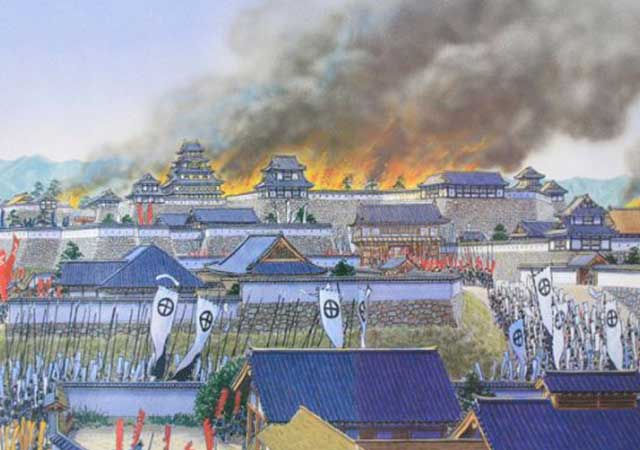
Fushimi can perhaps be considered one of the most “unfortunate” castles of the Sengoku Jidai period. The original castle was built by Toyotomi Hideyoshi in the southeast of Kyoto in 1594 as his residence in the imperial city.
-
The Siege of Otsu Castle
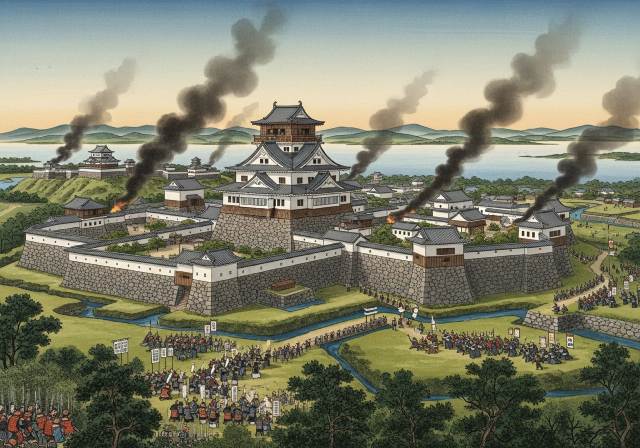
The siege of Otsu Castle was part of the Sekigahara campaign, during which the so-called Eastern Coalition, led by Tokugawa Ieyasu, fought against the Western Coalition, led by Ishida Mitsunari. Otsu Castle was built in 1586 by order of Toyotomi Hideyoshi near the capital Kyoto, on the site of the dismantled Sakamoto Castle. It belonged to the type of “water castles” — mizujō — as one side of it faced Japan's largest lake, Lake Biwa, and it was surrounded by a system of moats filled with lake water, which made the fortress resemble an island.
-
The Siege of Shiroishi Castle
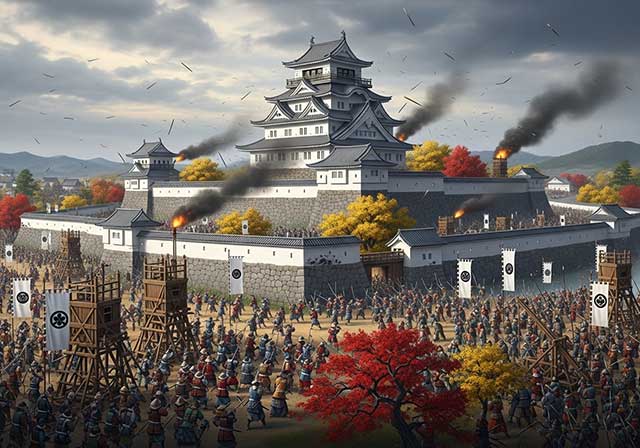
The siege of Shiroishi Castle was part of the Sekigahara campaign and took place several months before the decisive battle of Sekigahara. The daimyo of Aizu Province, Uesugi Kagekatsu, posed a serious threat to Tokugawa Ieyasu's plans to defeat the Western Coalition, and Ieyasu decided to curb his actions with the help of his northern vassals. To this end, he ordered Date Masamune to invade the province of Aizu and capture Shiroishi Castle.
-
The Second Siege of Jinju Castle
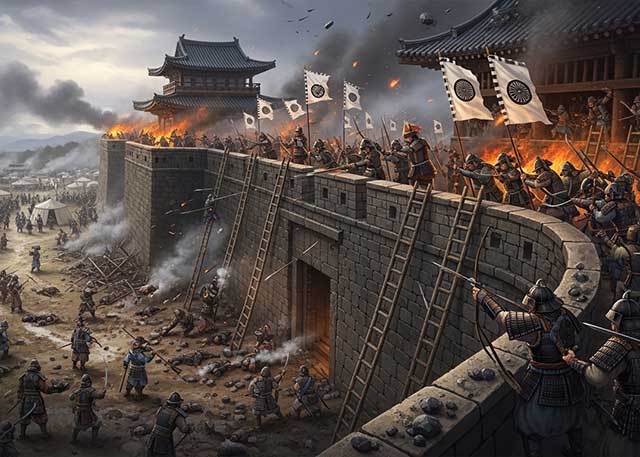
During the two Korean campaigns of the 16th century, the Japanese repeatedly had to capture enemy fortresses and defend occupied or constructed fortifications from the combined Korean and Chinese forces. Among all the operations of that time, the second siege of Jinju Castle is considered the most interesting from the point of view of siege warfare.
-
The Siege of Takamatsu Castle
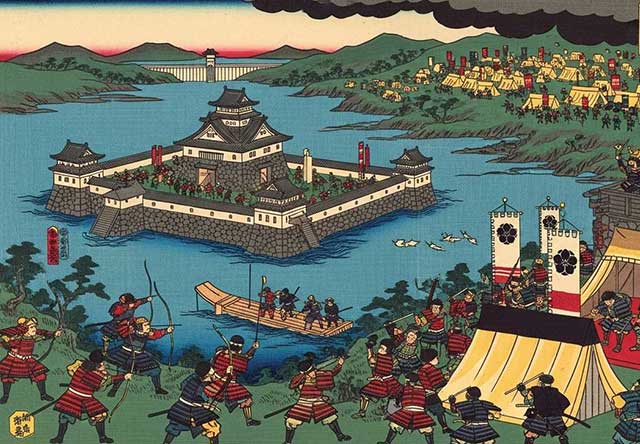
The siege of Takamatsu Castle in Bitchu Province is considered the first mizuzeme, or “water siege,” in Japanese history. Until then, such an original tactic had never been used.

